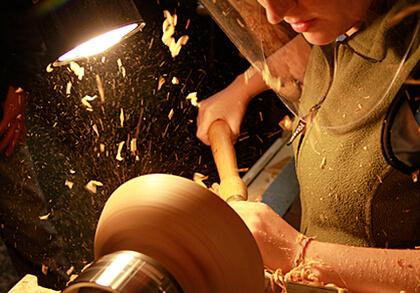In 1941, the University of Vermont acquired an exhausted farm in Jericho, Vermont. It was a place of sandy soils, rutted steep pastures, and few trees. But, in the last seven decades, the trees have grown back and the old farm has grown up into UVM's Jericho Research Forest.
This 500-acre parcel, 30 minutes from campus, is now part outdoor classroom, enlightened logging school, wilderness camp, research station, community center--and working model of ecological recovery.
Many aspects of this work will be on display, Saturday, Nov. 6, during an "Open Forest" event at the Jericho site. Free and open to the public, the Open Forest runs from 9 a.m. until 4 p.m., and the public is invited to attend all or part of the day's events. A bus will leave from the parking lot south of Jeffords Hall on the UVM campus at 8:30 a.m.
With talks, forest walks, bowl-making demonstrations, discussion of forest certification, tours of the 1832 Thompson House by the UVM Historic Preservation Program, and free make-your-own pizza (from the on-site wood-fired oven) the event is part of an ongoing "First Saturday Walk and Fire" series at the Jericho Forest sponsored by UVM's Green Forestry Education Initiative.
To learn more about life at the Jericho Research Forest, UVM Today dropped in on the director of UVM's Green Forestry Education Initiative, David Brynn. Here's our report:
A chance to practice
"Smell the bowl shavings," says Brynn. The shavings spray softly off the lathe like butter-colored confetti. They pile on the floor, and drift onto the arms of Marie Lenihan '12 as she coaxes a steel chisel into a spinning block of wood. The shavings smell like bread dough. "We like to turn cherry bowls because it's nice wood, but we also like it because it smells good," he says.
For the last five years, Brynn '79 G '91, has directed the Green Forestry Education Initiative centered here at the research forest. As the trees have re-grown, some of the old farm buildings have been repaired. Some, like the handsome 1832 farmhouse, are awaiting full restoration. Some trees have been harvested including exotic plantation species from an earlier era of forestry practice. Their wood has been transformed into lumber for repairing the buildings, boats at the Lake Champlain Maritime Museum, harvest tables at the GreenHouse residence on campus, firewood here in the workshop, and many other uses.
A lot of trees have sprouted, gotten bigger and died in seventy years. Recently, large, dead trees have been left standing, making bird-friendly snags. Downed trees have been left to rot, returning nutrients to the soil. It, too, has started to recover.
Through this change, Brynn, his forestry predecessors here, and many colleagues in the Rubenstein School of Environment and Natural Resources have used this place to help students think deeply about what it means to live on the land -- and then practice.
A bowl and some clay
One example of this practice is "Woodturning and Conservation" a course that Brynn co-teaches with bowl-maker Ralph Tursini '99.
"The class before us cut down the tree," says Marie Lenihan, a sociology major who is taking this course. She pauses from her lathe work and pushes her plastic visor onto the top of her head. "Then we cut the bowl blanks from the tree," she says, as well as having lessons in forest ecology, timber cruising, and logging-road design, "we're seeing bowls come from the tree."
Next to this shed, where four lathes hum, is another modest building. An old pole barn, really. Now it's the Orr Conservation Center, dedicated in 2008 and made possible through the family of the late Forrest E. Orr, an Orleans County forester and avid conservationist.
Walking in, Brynn places his hand on some rough-cut timbers and gray plasterwork. "This building has the hand and head of 65 students in it," he says. Several years ago, Mike Scott '10 and Andy Book '07, the then-president and co-president of the UVM forestry club, inventoried a white pine plantation here and made a management plan. They helped cut the trees that now form the walls of this building.
And the rough plaster? It's made from clay students dug nearby -- and mixed with "buckets and buckets of wood shavings from our bowl making," says Brynn. An ancient European form of wall insulating called "leichtlehmbau," it's cheap, breathable, and "has just about zero carbon footprint," says Brynn.
"This old barn has been transformed," says Brynn, "into a wonderful space for teaching and learning about healthy forests and sustainable communities. We walk the talk."
Making connections
This year, Brynn is stepping down as the director of the green forestry project but he will continue to teach classes -- and his first graduate student Brendan Weiner G '07, will come on as the project's coordinator under the leadership of professor Bill Keeton, the newly appointed head of UVM's forestry programs.
The goal of the whole green forestry project is connections -- so it's no surprise that Brendan Weiner has been out marking timber here at Jericho that will become part of the green renovations of the Aiken Center on campus.
Brynn points to the hand-built clay-topped pizza oven behind the Orr Center. A fire pops and cracks in it, as a thin bead of smoke rises. "Smell the wood as it's in the fire. Can you taste these woods in your flatbread pizza?" he asks, "The students can."
For more information about the Open Forest event, contact brendan.weiner@uvm.edu.
